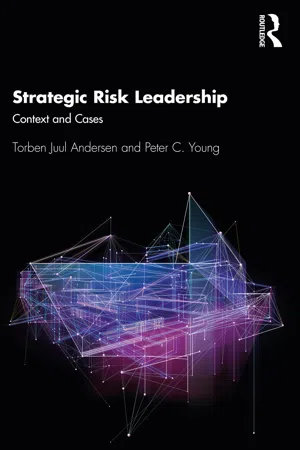Two target audiences also point toward two lines of inquiry with the intention of eventually knitting them together—the underlying goal being to establish risk leadership as a subject meriting more serious study. The first line of inquiry is to develop linkages to relevant leadership studies relying on the scholarly (and some professional) leadership literature. The second line is to discern and analyze the leadership role and functions as described and embedded in the risk management literature. We first provide a very short overview of the leadership literature followed by a brief review of the Risk Leadership concept as it has emerged over the past decade.
Leadership
A review of the entirety of scholarly leadership research is beyond the scope and intentions of this book—leadership is a highly complex subject of study with seemingly inconsistent (or competing) views across a vast literature. Leadership is not only a complex subject; it may also mean different things at different times and to different constituents.1
Leadership research has also evolved over time through influences of broader changes in society and its values. For example, the inclusion of both gender and race are essential elements in any contemporary view of leadership, which was not so evident in the past.2 Another development is the emergent focus on multi-directional leadership perspectives, e.g., bottom-up, lateral, and top-down, that reflect more nuanced ways of thinking about power and decision structures in contrast to long-held assumptions.3 These older assumptions include a view of the CEO (the Leader) and the executive team as being solely responsible for the formulation and enactment of a strategy to achieve intended objectives.4 Current challenges to that view are shaped by a growing interest in complexity—which opens the door to new ways of thinking about leadership.
Despite the daunting effort to summarize Leadership studies, the first steps are misleadingly simple. For more than 2,500 years, the focus was on the leader himself (yes, “him”). Various studies continue to analyze leadership based on the observed traits of individual leaders.5 Initially, these studies tended to be descriptive; seeking to uncover the divine attributes of the leaders—assuming that these were largely innate or inherited features—and, we note, the interest in these natural qualities has seen a certain resurgence.6 This approach coincides with the “upper echelons theory” as a widely adopted perspective in management studies to explain how organizational outcomes associate with—or derive from—particular executive traits.7 The early work on natural leadership traits eventually led to a search for attributes and skills as evidence of successful executive approaches that might be learned from conscious individual effort. This development extended the search for visible traits expressed in behaviors and actions taken by successful leaders.8 The result has been a fruitful area of research, producing a behavioral view of effective leadership.
A critical recognition of the importance of context and circumstances for executive decision-making has challenged the simple association between leadership traits and specific outcomes.9 This insight began a push toward a view of leadership as a contextualized process rather than “just” attributes and behaviors displayed by individual leaders. A common feature that emerged with process-oriented thinking was that leadership is not only a matter of a particular type of individual relying on specific traits to pursue the formulated organizational goals and objectives. Instead, leadership relies on a varying array of skills, knowledge, and attributes (and possibly some luck) when responding to and interacting within a specific environmental context. So, leadership would be different in different situations—a standardized set of traits and behaviors cannot be assumed to automatically work in any context.
In retrospect, it seems inevitable that consideration of contextual influences expanded to include the people who were to be led.10 The slightly inelegant but widely adopted term Followership captures the idea that a leader must have followers. Thus emerged the idea that Leadership studies should acknowledge the interactions between the Leader, the Followers, and the Context triad to achieve a more comprehensive understanding of leadership. A widely used textbook captures the essence of this view by defining Leadership as: “a process whereby an individual influences a group of individuals to achieve a common goal.”11
There are dozens of competing definitions, some more detailed, but this definition conveys in 15 words a recognition of the central presence of leaders, followers, and context—as well as the view that leadership is defined by the interactions between these elements. And it employs the concept of process and even hints at a moral foundation for leadership.
A few other points deserve highlighting—all will receive further attention throughout the book.
In the search for alignment between the Risk Leadership idea and ...
